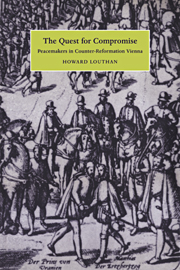Book contents
- Frontmatter
- Contents
- List of illustrations
- Acknowledgments
- A political and cultural chronology
- List of abbreviations
- Introduction
- PART I THE EMERGENCE OF AN IRENIC COURT
- PART II MAXIMILIAN II AND THE HIGH POINT OF IRENICISM
- Introduction
- 3 Hugo Blotius and the intellectual foundation of Austrian irenicism
- 4 Ordering a chaotic world: the reformation of the imperial library
- 5 Protestant ecumenism and Catholic reform: the case of Johannes Crato
- 6 Finding a via media: Lazarus von Schwendi and the climax of Austrian irenicism
- PART III THE FAILURE OF IRENICISM
- Conclusion: Storm clouds on the horizon: from the great milk war to the Thirty Years War
- Epilogue: The wider circle of irenicism
- Select bibliography
- Index
- CAMBRIDGE STUDIES IN EARLY MODERN HISTORY
5 - Protestant ecumenism and Catholic reform: the case of Johannes Crato
Published online by Cambridge University Press: 03 December 2009
- Frontmatter
- Contents
- List of illustrations
- Acknowledgments
- A political and cultural chronology
- List of abbreviations
- Introduction
- PART I THE EMERGENCE OF AN IRENIC COURT
- PART II MAXIMILIAN II AND THE HIGH POINT OF IRENICISM
- Introduction
- 3 Hugo Blotius and the intellectual foundation of Austrian irenicism
- 4 Ordering a chaotic world: the reformation of the imperial library
- 5 Protestant ecumenism and Catholic reform: the case of Johannes Crato
- 6 Finding a via media: Lazarus von Schwendi and the climax of Austrian irenicism
- PART III THE FAILURE OF IRENICISM
- Conclusion: Storm clouds on the horizon: from the great milk war to the Thirty Years War
- Epilogue: The wider circle of irenicism
- Select bibliography
- Index
- CAMBRIDGE STUDIES IN EARLY MODERN HISTORY
Summary
It is significant that the high point of irenicism in Habsburg Vienna corresponded with the reign of Maximilian II (1564–1576), for the most prominent feature of this phenomenon was its confessional neutrality. Maximilian's predecessor, Ferdinand I, though a tolerant ruler in many respects, was a loyal son of the Catholic church. Ferdinand had officially invited the Jesuits to the Austrian lands. Ferdinand's grandson, Rudolf II, was raised by a zealous Catholic mother. He had been educated in Spain at the court of his orthodox cousin, Philip II, and at the beginning of his reign he did indeed support more vigorous policies of Catholic reform. When he succeeded his father in 1576, a papal representative described the new emperor as “most Catholic and very religious.” Maximilian, the adiaphorist, stood in contrast to both his father and son.
The enigmatic religious convictions of Maximilian II have puzzled historians since the emperor's death in 1576. A conflicting series of deathbed reports confuse the matter. A papal observer confirmed that Maximilian died an orthodox Catholic while others maintained that the Habsburg remained a crypto-Protestant to his last hour. Though historians have yet to reach a consensus on this issue, there are a few facts that can be agreed upon. From an early age he had a broad exposure to Protestantism. One of his first tutors was the Alsatian Wolfgang Schiefer who taught the young prince at Innsbruck between 1536 and 1538 before it was discovered that he was a Lutheran. Schiefer had studied at Wittenberg and was a friend of Philip Melanchthon, Joachim Camerarius, Ulrich von Hutten and Luther himself.
- Type
- Chapter
- Information
- The Quest for CompromisePeacemakers in Counter-Reformation Vienna, pp. 85 - 105Publisher: Cambridge University PressPrint publication year: 1997



